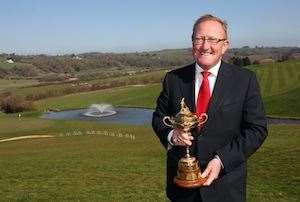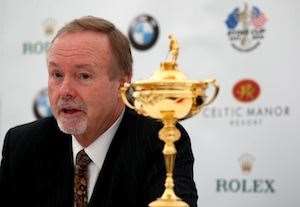With the Ryder Cup returning to Scotland next month, John Huggan examines how the modern Cup is more about profit than purity of the game.
BY JOHN HUGGAN
You may or may not have noticed, but June 23rd this year marked something other than Colin Montgomerie’s 51st birthday. With great fanfare – and no hint of embarrassment or irony – the European Tour that day announced the opening of what is grandly titled the “Official Bidding Process for the 2022 Ryder Cup.”
 The European Tour’s Ryder Cup Director Richard Hills poses with the trophy at Celtic Manor. PHOTO: Getty Images
The European Tour’s Ryder Cup Director Richard Hills poses with the trophy at Celtic Manor. PHOTO: Getty ImagesEven more hilariously, the press release accompanying this monumental waste of time breathlessly described the process – the one that identified France as the best place for the 2018 matches – as an “unqualified success.” The European Tour’s ‘Ryder Cup Director’ Richard Hills actually went even further, labelling the methodology as “fair, transparent and objective.”
Aye right, as they say here in Scotland.
The key, as ever, is in the detail. Number four on the five-strong list of criteria any bidding country must meet is “commercial opportunities available to the Ryder Cup.” In other words, this pantomime is all to do with money and very little to do with golf. For “Ryder Cup” read “European Tour.”
Don’t get me wrong. Because the European Tour provides the 12 players – a legitimate bone of contention for European-born players deemed ineligible simply because they are not members – it is, to be fair, entitled to at least a considerable cut of the massive revenues generated by the biennial battle between Old and New Worlds. But, in the interests of equal fairness, the green-jacketed gang based at Wentworth near London shouldn’t be sole arbiters when it comes to identifying the actual size of their remuneration.
But they are.
Okay, let’s not be completely naïve either. Like it or not, commercial realities have to play a role in this murky scenario. The European Tour is a business and must behave like one. And the fact is that every home Ryder Cup basically funds the various activities of the Tour until the next one comes along. So it follows that every legitimate effort must be made to maximize profits.
Here’s the thing though. Should those profits take precedence over, say, the quality of the venue to quite the extent that they clearly do? Even a brief glance at the recent history of the Ryder Cup tells us that the stature of the host courses on the eastern end of the Atlantic has, since 1981 at the estimable Walton Heath, left more than a little to be desired. The stage on which golf’s most dramatic event is played out doesn’t seem to carry too much weight in the decision-making process.
The prima facie evidence is clear enough. In 1985 the Ryder Cup was played at the then awful Belfry in the English Midlands, primarily because that is where the British PGA makes its headquarters. Accommodation in exchange for worldwide publicity was clearly the deal in place.
That little arrangement was perhaps fair enough one time, but the Ryder Cup was back at The Belfry in 1989 and again in 1993. Yes, the course saw some improvement over those eight years. But it remained uninspiring at best, it’s only redeeming qualities two brilliant “match play” holes – the short and sometimes drivable par-4 10th and the water-strewn 18th.
In 1997, the matches were played outside the United Kingdom for the first time, at Valderrama in Spain. The public message was that the Ryder Cup was morally bound to visit the homeland of non-playing skipper Seve Ballesteros. But the unspoken reality was that Samuel Ryder’s little golf trophy had been “purchased” by Bolivian billionaire, Jaime Ortiz-Patino, owner of the host venue.
 Multi-millionaire Sir Terry Matthews campaigned strongly to host the Ryder Cup at Celtic Manor in 2010. PHOTO: Getty Images.
Multi-millionaire Sir Terry Matthews campaigned strongly to host the Ryder Cup at Celtic Manor in 2010. PHOTO: Getty Images.Europe’s next home game was back at The Belfry, albeit a year late because of the terrorist atrocities perpetrated on the United States on September 11 2001. And since then the matches have returned to the template established in ’97. 2006 was “bought” by Irish businessman Michael Smurfit and played at the tedious K Club. And 2010 went to the equally mediocre Celtic Manor resort in Wales, owned by yet another multi-millionaire, Sir Terry Matthews.
This year’s matches will be no different in terms of the quality of venue. The PGA Centenary course at Gleneagles – home of the world famous Kings and Queens courses – represents the fourth-best track in the local village of Auchterarder … and is ranked that high only because there aren’t five courses to choose from.
At this point, apologists will surely point to an undeniable fact: the Ryder Cup consistently provides more entertainment than any other event anywhere on the planet. But that has more to do with the match play format than it does the land on which those contests are held. Yes, you could play the Ryder Cup at the most nondescript municipal course in any remote backwater and it would still provide a plethora of thrills and spills. But is that really enough? I say it is not. The Ryder Cup deserves better.
Related Articles

Feature Story: Oakmont Unleashed

Ogilvy: U.S Open's toughness means testing limits

Column: The Hard Way Pays
Latest News

Golf Improvement Tour of Glorious Vietnam

Playing From The Tips Ep.119: John Deere, BMW International Open & International Series

Faltering Reed wins play-off for maiden LIV Golf title
Most Read

RANKING: Australia's Top-100 Public Access Courses for 2025

RANKING: Australia's Top-100 Courses for 2024

Rocket Classic tee times (AEST): Aussies Lee, Davis, Vilips and Baddeley in action






